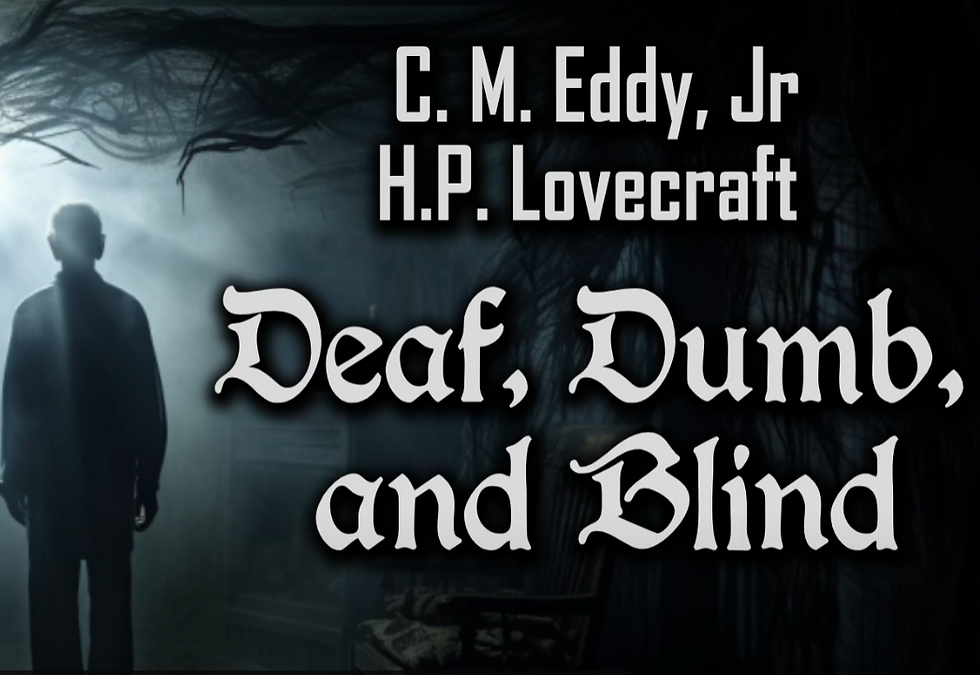Tony's Review of "Beyond the Wall of Sleep"
- Tony Travis

- Dec 28, 2024
- 3 min read

Beyond the Wall of Sleep is an evocative dive into the liminal space between dreams and reality, where the boundaries of human perception dissolve, and we glimpse realms tantalizingly out of reach. Published in 1919, this short story reflects Lovecraft’s early fascination with the cosmos, the mind’s potential, and the unnerving idea that the universe is far vaster and more incomprehensible than we can imagine. While it lacks the polished intricacy of his later works, it captures his hallmark themes of insignificance, otherworldly beauty, and terror in equal measure.
The story unfolds through the perspective of an unnamed narrator, a medical intern at a mental hospital who becomes intrigued by a violent, troubled patient named Joe Slater. Slater, a man from the Catskill Mountains, is plagued by vivid, otherworldly dreams that he cannot comprehend but fears deeply. Through his fragmented descriptions, the narrator pieces together a vision of Slater’s nightly journeys beyond the physical world into a realm of light, energy, and astral battles.
What makes Beyond the Wall of Sleep so compelling is its fusion of science, mysticism, and Lovecraft’s burgeoning cosmic philosophy. The narrator, fascinated by Slater’s experiences, builds an experimental device to link their minds during sleep. This premise, while grounded in speculative pseudoscience, demonstrates Lovecraft’s early willingness to push beyond the limits of conventional storytelling. The story isn’t about plot mechanics but the tantalizing possibilities of what lies beyond ordinary perception.
The narrative truly shines in its descriptions of the dreamlike realms Slater visits. Here, Lovecraft’s imagination takes flight, creating radiant vistas of energy, celestial forms, and beings that defy earthly comprehension. There’s a beauty in his language that balances the story’s more horrific undercurrents. Lovecraft invites us to wonder: What lies beyond the veil of sleep? Are our dreams mere figments of our subconscious, or do they open doorways to other dimensions?
Yet, for all its ambition, the story isn’t without flaws. The characters are thinly developed; the narrator serves more as an observer than an active participant, and Slater—despite being the crux of the story—remains an enigma, more a vessel for Lovecraft’s ideas than a fully fleshed-out character. Additionally, the structure occasionally feels uneven, with philosophical musings sometimes overshadowing the tension of the central mystery.
One notable and uncomfortable aspect is the clear bias the narrator and his colleague's display. Slater is degraded in ways that reflect racial and cultural prejudices, reducing him to a caricature of “the other.” While this was written over a century ago and reflects the prevailing attitudes of its time, it makes for difficult reading today. It serves as a reminder of how far society has come—and how far we still have to go—in addressing such biases.
Despite its shortcomings, the themes Lovecraft explores resonate deeply. Slater’s journey beyond the wall of sleep hints at the fragility of human consciousness and the tantalizing yet terrifying possibility that we are part of a much larger, unknowable universe. Lovecraft’s trademark existential dread is present here, albeit in an embryonic form. The revelation that Slater’s soul is connected to a celestial being locked in an eternal cosmic struggle feels both awe-inspiring and profoundly alienating—a reminder that humanity’s place in the cosmos is minuscule.
In the end, Beyond the Wall of Sleep is essential reading for anyone interested in Lovecraft’s development as a writer. While it lacks the scope and polish of his later works, it offers an intriguing glimpse into his evolving fascination with the limits of human understanding and the infinite mysteries that lie just beyond our reach.



Comments